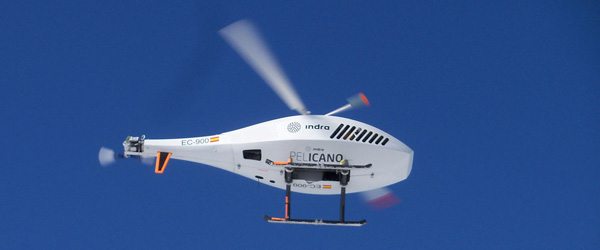Indra’s new UAV, the Pelicano helicopter, performed a test flight this morning at the Marugán aerodrome in the province of Segovia. This test marks the market launch of Indra’s new unmanned helicopter system, which is now ready to enter into service. T
he flights took place as part of UNVEX’12, the Spanish conference for unmanned systems that is holding its second edition in Madrid this week.
Indra has presented its family of unmanned solutions at this industry event, including the Mini-UAV Mantis, the latest version of the Pelicano rotary wing UAV, as well as the communications, IFF transponder and remote video terminal equipment for the Atlante programme, which the company is developing together with the Cassidian company.
During the flight, the Pelicano completed the previously established mission with complete autonomy from take-off to landing. The helicopter sent in real time the images captured by the payload, which in this case was a state-of-the-art electro-optical system developed by the company, to the ground station and the monitoring screens installed by UNVEX’12 organisers.
Given the difficult weather conditions at the Marugán aerodrome throughout the day, the PELICANO system, which has been designed to be used in all types of conditions, was one of the two only systems that was able to take-off and carry out the scheduled exhibition while operating as usual.
Ready to board
Indra presented at UNVEX’12 the final configuration of the Pelicano system, including the naval version of the aircraft, which is ready to operate from the flight decks of Navy ships–such as BAM patrol boats or F80 and F100 series vessels–or of Civil Guard patrol boats.
The Pelicano system is capable of operating more than six hours with its full payload for intelligence, surveillance and piracy control missions, like the ones that are currently carried out by the European Union vessels that have been deployed along the coast of Somalia.
The modifications carried out for the naval configuration include integrating a heavy-fuel engine to comply with the requirements of most Navies for safety and logistical reasons. Indra has also developed a specific system that will allow the helicopter to automatically approach and land on a ship’s deck, even in the worst weather conditions.
The Pelicano system is the only aircraft of its type that has been designed from the onset for naval use and it also shows Indra’s high technological abilities in this field.
Aside from the aircraft, Indra presented the ground station for the Pelicano system at UNVEX’12. This system is equipped with three pilot and payload operator stations, and it is installed in a standard military-type container for easy deployment. The ground station is capable of controlling two aircraft at the same time and it is equipped with the latest image processing and ergonomic advances to facilitate missions with a long duration as well as an optimal use of information.
The land version of the Pelicano system can be transported in a 4×4 vehicle and deployed in less than half an hour. It is capable of covering the operational needs of a short range unmanned tactical aircraft system (up to 150 km from the control station) and carry out surveillance missions to protect ground forces.
Indra has also launched a simplified version of the system that is equipped with a variety of payloads and adapted to the operating needs of police forces and emergency teams for surveillance missions, managing emergencies and searching for survivors. The various Pelicano system versions will be ready to progressively enter into service throughout 2012.
A complete family of solutions
Indra also brought its Mini-UAV Mantis to this UNVEX edition. This system has been developed to protect troops involved in international operations. It consists of a solution that can be transported by one or two soldiers, it is easy to assemble and operate, and offers the ability to observe what lies within a 30 km radius. This increases awareness of the situation and the safety of troops that operate within areas of conflict.
Indra has also presented some of the devices it has developed as part of the Atlante programme at UNVEX. This programme, in which Indra participates as a partner and is led by Cassidian, has the objective of developing a long range tactical UAV. Indra provides the primary and secondary data links, the electro-optical payload, the image processing software, the remote video terminal (RVT), the identification friend or foe (IFF) system and the emergency locator for the vehicle in the event of a parachute landing.
The UNVEX event has served as a forum for experts from more than thirty companies, public bodies and universities to share their vision of the current situation and industry challenges. The director of Indra’s Unmanned Systems, Pablo González, centred the company’s presentation on analysing technological needs in order to guarantee the safety and integration of UAVs within Europe’s civil airspace. This objective is key for industry and market growth by allowing to expand the applications of these aircraft to other areas such as the security and surveillance of borders, infrastructures, roads, forests and many other areas.
Daniel Cobo, who is responsible for UAS airworthiness at Indra, analysed the special characteristics involved in the Airworthiness Certification (military as well as civil) of these types of systems. Indra has been a pioneer in Spain in this field. In 2012, the company completed the Experimental Airworthiness Certification processes for the Army’s PASI system (currently deployed in Afghanistan) as well as the Pelicano system.
Indra is the number one IT multinational in Spain, and one of the leaders in Europe and Latin America. It is the second European company in its sector in terms of R&D, with more than €500 million invested in the last three years. Its 2011 revenues were €2.688 billion, and its international activities already represent 50%. The company employs more than 36,000 professionals and has customers in 118 countries.










